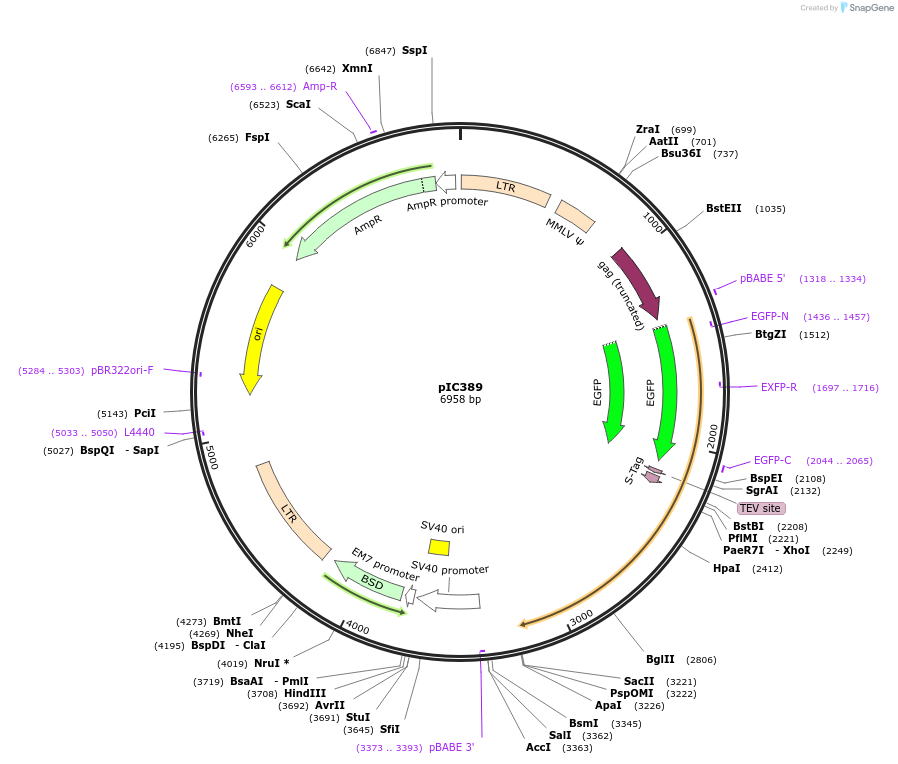pIC389
(Plasmid
#37387)
-
Depositing Lab
-
Sequence Information
Ordering
| Item | Catalog # | Description | Quantity | Price (USD) | |
|---|---|---|---|---|---|
| Plasmid | 37387 | Standard format: Plasmid sent in bacteria as agar stab | 1 | $89 | |
Backbone
-
Vector backbonepBABE
-
Modifications to backboneThis contains a blasticidin resistance gene for selection in eukaryotic cells.
-
Vector typeMammalian Expression, Retroviral
-
Selectable markersBlasticidin
Growth in Bacteria
-
Bacterial Resistance(s)Ampicillin, 100 μg/mL
-
Growth Temperature37°C
-
Growth Strain(s)DH5alpha
-
Copy numberUnknown
Gene/Insert
-
Gene/Insert nameLGN
-
Alt nameGPSM2
-
SpeciesH. sapiens (human)
-
Insert Size (bp)963
-
Mutationdeleted amino acid 1-364 and 524
-
GenBank IDNP_037428.3
-
Entrez GeneGPSM2 (a.k.a. CMCS, DFNB82, LGN, PINS)
-
Tags
/ Fusion Proteins
- GFP (N terminal on insert)
- TEV (N terminal on insert)
- S-tag (N terminal on insert)
Cloning Information
- Cloning method Restriction Enzyme
- 5′ cloning site XhoI (not destroyed)
- 3′ cloning site SacII (not destroyed)
- 5′ sequencing primer GGCATGGACGAGCTGTACAAG
- 3′ sequencing primer GCATTCATTTTATGTTTCAGG
- (Common Sequencing Primers)
Resource Information
-
A portion of this plasmid was derived from a plasmid made byORIGENE, SC111910
Terms and Licenses
-
Academic/Nonprofit Terms
-
Industry Terms
- Not Available to Industry
Trademarks:
- Zeocin® is an InvivoGen trademark.
Depositor Comments
Please note that Addgene's sequencing results have confirmed that bp# 2734-2736 in the full plasmid sequence provided by the depositing laboratory are deleted in this plasmid, resulting in the deletion of amino acid 524 in the LGN sequence.
These plasmids were created by your colleagues. Please acknowledge the Principal Investigator, cite the article in which the plasmids were described, and include Addgene in the Materials and Methods of your future publications.
-
For your Materials & Methods section:
pIC389 was a gift from Iain Cheeseman (Addgene plasmid # 37387 ; http://n2t.net/addgene:37387 ; RRID:Addgene_37387) -
For your References section:
Chromosome- and spindle-pole-derived signals generate an intrinsic code for spindle position and orientation. Kiyomitsu T, Cheeseman IM. Nat Cell Biol. 2012 Feb 12;14(3):311-7. doi: 10.1038/ncb2440. 10.1038/ncb2440 PubMed 22327364



